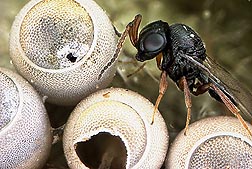This page has been archived and is being provided for reference purposes only. The page is no longer being updated, and therefore, links on the page may be invalid.
| Read the magazine story to find out more. |
|
|
Detailed Images Aid Studies of Beneficial Wasps
By Jan Suszkiw
August 25, 2014
Using specialized digital photography methods, U.S. Department of Agriculture (USDA) scientists are producing high-resolution images of members of the wasp superfamily Platygastroidea.
Of particular interest is using the images to improve the identification and taxonomic description of one- to two-millimeter-long Trissolcus wasp species that parasitize stink bugs and could have potential as biological control agents. The wasps' larvae hatch and feed inside the bug's eggs, killing them in the process. Some species attack the eggs of the brown marmorated stink bug (BMSB), an invasive pest from Asia that's become established in 39 U.S. states and, in 2010, inflicted $37 million in damage to corn, soybeans, grapes and other crops.
According to Elijah Talamas, a post-doctoral scientist with the Agricultural Research Service (ARS) Systematic Entomology Laboratory in Washington, D.C., the photographic process begins with positioning a wasp specimen under a specialized camera with a single-column lens attached to a vertical joist, and then taking stacks of photographs throughout the depth of the specimen.
Each photograph contains a small part of the insect in focus due to the small depth of field at high magnification. The "slices" are then combined into a single, highly detailed digital image magnified up to 100 times the specimen's original size. The image is uploaded to online databases operated by university cooperators and linked to interactive keys, which guide users to specimen descriptions and other information.
Each specimen has a unique identification number—a collecting unit identifier (CUID)—which allows a user to determine the specimen's origin on a species distribution map. Taxonomists can refer to a specific specimen via its CUID without ambiguity, according to Talamas.
His efforts provide valuable taxonomic support to ARS researchers in Newark, Delaware, who are examining the host specificity and safety of several Asian Trissolcus species with potential use in biocontrol release programs against BMSB.
Read more about this work in the August 2014 issue of Agricultural Research magazine.
ARS is the USDA's principal intramural scientific research agency.

